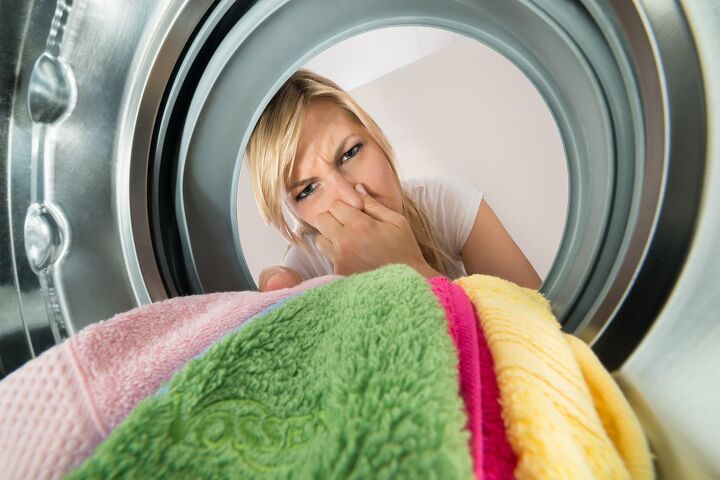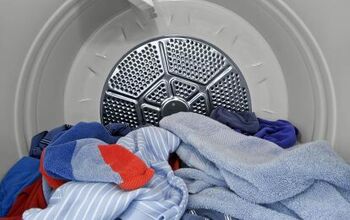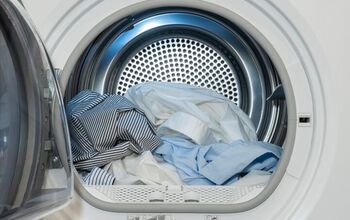Is There A Mildew Smell In The Dryer? (Possible Causes & Fixes)
One of the most discouraging feelings is opening up your dryer and smelling mildew. You just ran a cycle of clean laundry, and yet your clothes smell like a gym locker. This stale, musty odor is really frustrating to discover in your laundry room. So why does your dryer smell like mildew?
A mildew smell in your dryer may be the result of built-up lint that has grown mildew. Wet clothes left in the dryer too long may also be the cause. Your dryer might also have a clogged dryer vent. Get rid of the mildew smell by cleaning the lint trap and vent hose, and washing the dryer drum.
Keep in mind, mildew smells musty, like stinky socks, and isn’t the same as mold. Mildew has a powdery consistency, and a weaker scent. It’s less damaging to your health than mold. It is also easier to clean. If your dryer smells really pungent and offensive, you may actually have mold.
Related Guide: Musty Smell In The Laundry Room?
Do You Need a Maid Service?
Get free, zero-commitment quotes from pro contractors near you.

Why Does Dryer Smell Like Mildew?
Luckily, a case of smelly dryer isn’t too difficult to diagnose and cure. With regular cleaning and taking the right precautions, mildew smells can be prevented. And since mildew is an earlier stage of mold, it’s good to catch it as early as possible. Here are the most likely scenarios for why your dryer smells like mildew.
Wet Clothes Sitting in Dryer
One of the most likely and easy to solve causes of mildew smell is your damp clothes. We all know what it’s like to be in a rush. We’re running late for work, so we pull a sopping wet laundry load from the washer and stick it in the dryer. But then we forget to hit START on the dry cycle. Then the wet clothes sit there in the dryer drum for hours.
When moisture collects inside a warm, unventilated space, it will begin growing bacteria. Wet objects like clothing attract mold very quickly. Sometimes all it takes is 24-48 hours of damp fabric for it to collect mold spores and toxins.
Wet clothes that sit in your dryer for too long can cause mildew to start growing. This mildew can grow on the clothes themselves, in the dryer drum, or in the lint trap. The key is to finish the drying cycle as soon as possible. Also ensure there is ventilation in your laundry room. Dry out your machines by keeping the doors open after use.
Mildew or Mold in Lint Trap
Another common offender of mildew smell in the dryer is a dirty lint trap. When lint from your clothes collects in the lint trap for too long, it can start to grow mildew and mold. Just like your damp clothing sitting in the dryer, this lint is moist and in an unventilated space. This creates the perfect breeding ground for bacteria to thrive.
To prevent this, remove the lint from the lint screen after every drying cycle. This prevents the lint trap from growing mold. You can use a paper towel or rag to do this. And if the mildew is still a problem, remove the lint screen and clean it. You can do this by soaking it in distilled vinegar and washing it in hot water.
Note: Regularly cleaning out lint from the trap is very important. Built-up lint and dust are the leading cause of dryer fires.
Has your lint trap grown black mold? It’s probably past the point of handwashing. You will need to replace it. This type of mold is bad for your health and should be taken seriously. It can also affect the cleanliness and smell of your clothing.
Clogged Dryer Vent
A clogged dryer vent is a very common but overlooked cause of bad smells in your dryer. While you might regularly clean the lint from the lint screen, it doesn’t catch everything. Lint, dust, paper, and other fabrics get pulled from your clothes.
Sometimes these items get lodged in the vent as the air heads through the vent hose on its way out of the house. The result of this damp buildup is bacterial growth, resulting in mildew and mold. Venting your dryer through the roof or directly outdoors can help prevent these clogs.
How can you tell if you have a clogged dryer vent? Here are some signs:
- A sour, musty mildew smell in your laundry room.
- Your clothes are still damp after a cycle that used to fully dry them.
- You see lint accumulating near the vent.
- The dryer is very hot to the touch after use.
- There is leaking water on the floor under your dryer or near the vent.
If your dryer vent is clogged, you will need to clean out the debris. Fortunately, you can do this yourself by taking these steps.
- Unplug the dryer, pull away from the wall.
- Unscrew and disconnect the vent from the dryer.
- Using a vent brush, pull out the accumulated lint.
- Vacuum the inside of the vent hose to collect remaining debris. Go to the outside portion of the vent. Then unscrew the cover and pull out any lint with a vent bush.
- Reattach the vents, push the dryer back in place. Make sure to leave a little space between the dryer and the wall to allow ventilation.
How to Clean and Prevent a Smelly Dryer
Now that you understand why your dryer smells like mildew, it’s time to remove the odor. You should take these steps to clean all the trouble spots. Then ensure that in the future, you follow all the necessary precautions to prevent any more gross smells. With regular cleaning and lint removal, it is relatively easy to prevent this.
Step One: Clean the Dryer Drum
If mildewy or damp clothes have been sitting in your dryer, mildew may be growing in the drum. But how can you tell if the mildew smell is coming from your clothes, or the dryer itself?
After you finish a drying cycle, remove all your clothing. Let the dryer sit with the door open for at least an hour. Then come back and take a whiff inside – does it still smell musty inside? If so, you should clean out your dryer drum.
Follow these steps to clean out your dryer thoroughly.
- Create a mixture of one-part distilled vinegar, one-part water in a spray bottle. You can also use bleach instead of vinegar.
- Spray down the inside walls of the dryer drum.
- Thoroughly wipe down the inside walls of the dryer drum. Let air dry.
- Soak a towel in cold water and a good amount of baking soda.
- Run the towel through a low-setting dry cycle. This should absorb the mildew smell.
Step Two: Clean and Replace Lint Trap
You should make sure to clean any lint from the lint trap after every dryer cycle. This is to prevent both mold and mildew growth, and potential dryer fires. Pull out the screen from the lint trap, and drag a damp cloth or paper towel across it to collect the lint.
To take it a step further, you can deep clean the lint screen. This is good to do if you suspect mildew is growing on it. Dip a toothbrush in a solution of distilled vinegar and water,
Step Three: Ventilate Laundry Room and Machines
A lack of ventilation in your laundry room contributes to the growth of mildew. When moisture collects in a warm, confined space, bacteria thrive. This growth of mildew and mold emits that unpleasant musty smell.
To prevent future bad smells, make sure you always properly ventilate your laundry room. Keep the door to the laundry room open, especially after running the washer and dryer. Keep the dryer and washer doors open after use so the machines can air out. Washing machines are highly susceptible to mildew smells.
Step Four: Dry Your Laundry Properly
In addition to ventilating your laundry room, make sure to dry your clothes properly. Moisture trapped in a warm confined space is a breeding ground for mildew. One of the most common causes for a smelly dryer is leaving wet clothing in the dryer too long.
Make sure you run your drying cycle as soon as you put a load in. Be sure to check that your clothes are fully dry once the cycle is complete.
As a precaution, try only running small or medium loads. Large loads produce more lint, which can collect and contribute to mold growth. Large loads also take longer to dry, and can contribute to a damp, mildewy dryer.
Do You Need a Maid Service?
Get free, zero-commitment quotes from pro contractors near you.

Related Questions
Mildew smell in itself is not dangerous. The CDC reports that only when mildew develops into mold does it cause irritation. Inhaling mold can cause throat irritation, a stuffy nose, eye irritation, or coughing and wheezing. Prolonged exposure to mildew smell can cause these same symptoms. It is important to treat the mildew or mold after early detection.
Where does mildew grow?Mildew can grow in a variety of home environments. The most common places to find mildew are in bathrooms and showers, on natural fabrics like cotton and linen, plants, foods, woods, decaying organic matter, and other locations where leaks or moisture buildup occurs.
What type of dryer vent is best?To avoid dryer vent issues like clogs, look into installing the right dryer vent for your home. Consider the orientation of your laundry room and shape of your home first. If you have a basement or second-floor laundry, choose a dryer vent connected to the wall by duct work. Laundry rooms on the ground floor against the back south wall would benefit from a flexible steel or metal dryer vent.
More by Jessica Vaillancourt

























![How To Reset A Whirlpool Cabrio Washer [In 5 Easy Steps!]](https://cdn-fastly.upgradedhome.com/media/2023/07/31/9076531/how-to-reset-a-whirlpool-cabrio-washer-in-5-easy-steps.jpg?size=350x220)

